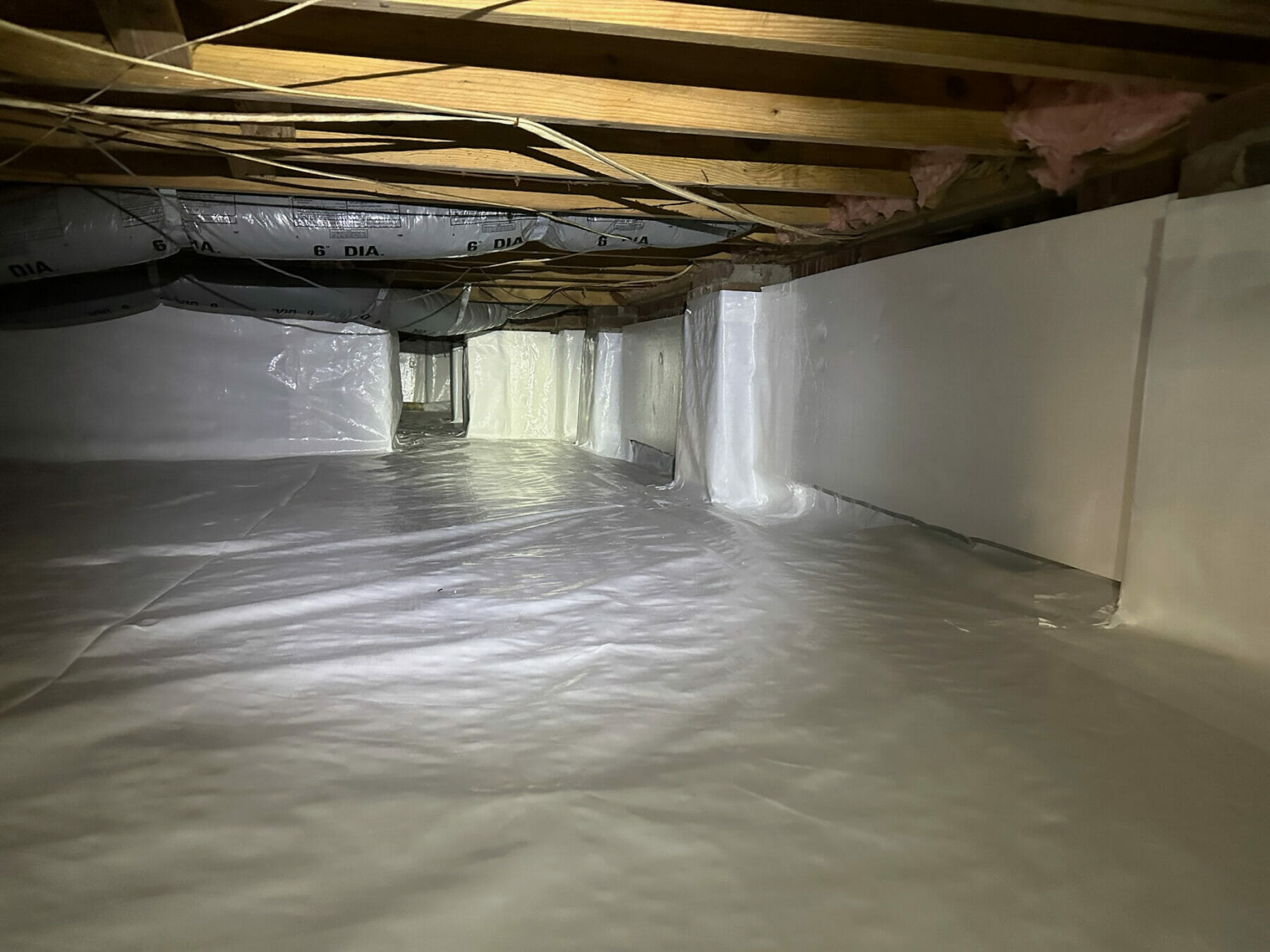That musty smell creeping up from your floors? It’s not just an old-house quirk—it could be a sign of a bigger issue lurking below. For many homes in the Goldsboro, NC, area, the crawl space is often the culprit, especially if the vapor barrier is old, damaged, or missing altogether.
Replacing your crawl space vapor barrier may not be the most exciting home project, but it can make a huge difference. It helps protect your home from excess moisture, improves air quality, and can even prevent structural issues in the long run. It’s peace of mind you can feel with every step you take upstairs.
In this article, we’ll cover what a crawl space vapor barrier does, its lifespan, and signs that it’s probably time for a new one.
What Does a Crawl Space Vapor Barrier Do?
A crawl space vapor barrier is typically a sheet of heavy-duty plastic, usually polyethylene vapor barrier material, laid across the dirt floor of your crawl space. It often extends up the foundation walls partially. Its primary function is to block ground moisture from entering your home and impacting energy efficiency.
This is very important because excessive ground moisture creates many problems. It can lead to wood rot in floor joists and beams, causing structural damage. This moisture can also corrode pipes and ductwork within the crawl space, leading to costly crawl space repair.
Beyond stopping liquid water, an effective vapor barrier also safeguards your indoor air quality. Soil beneath your house can release various substances, including harmful gases such as radon. A correctly installed and intact plastic vapor barrier helps keep these gases out of your living space.
Condensation occurs when warm, moist air from your home contacts the cooler, damp air in crawl spaces. The barrier helps manage this, especially in humid climates where mold growth is a concern. Ultimately, it combats mold, mildew, and general decay caused by excessive crawl space moisture.
How Long Should a Vapor Barrier Last?
You might wonder, “How often do I need to address this?” That’s a reasonable query. A properly installed, high-quality crawl space vapor barrier can last 15–20 years, or even more. However, its lifespan can vary based on several factors.
The initial installation quality is critical. Incorrect installation, gaps, or using thin mil plastic can lead to early failure. Your local environment and climate also play significant roles. Homes in very damp regions or areas prone to standing water might experience faster degradation of their space vapor barriers.
Unexpected events also impact longevity. Pest control is important, as animals such as raccoons and mice can tear through plastic sheeting if they access the crawl space beneath your home. Even minor plumbing leaks, if left unchecked, can damage the barrier over time and contribute to moisture problems. A history of crawl space flooding drastically shortens its lifespan, potentially requiring basement waterproofing techniques for better protection.
Signs It’s Time To Replace a Crawl Space Vapor Barrier
Recognizing when to replace crawl space vapor barrier materials involves some observation. Certain signs indicate it’s time for a change. Remember, if you discover moisture problems, address the root cause, such as a plumbing leak or poor outdoor drainage, before installing a new vapor barrier. Otherwise, you’re merely masking the crawl space problem, which could escalate.
Addressing the source of water vapor or standing water is the first step. This might involve grading issues around your foundation or even installing a sump pump. Once these are fixed, assess the state of your existing space vapor barrier.
Leaks and Persistent Dampness
If your crawl space experiences noticeable leaks or has issues with standing water, this is a major warning. After resolving the water source, the old vapor barrier is likely compromised. Addressing the leak or drainage issue effectively often means proceeding with a full crawl space encapsulation for comprehensive protection.
Obvious External Damage
Significant events can cause visible damage. A major flood impacting your crawl space, nearby ground erosion, or animal activity, such as nesting in the plastic laid on the dirt floors, can compromise your barrier. If such events occur, plan to replace the old material with new, robust plastic sheeting.
Punctures, Rips, and Tears
Any hole, regardless of size, can compromise the seal that your crawl space vapor is meant to provide. Small punctures might be repairable with butyl tape if they’re isolated. However, multiple rips, large tears, or brittleness mean the sheeting’s integrity is lost, and a replacement is necessary to prevent further issues.
A damaged barrier fails to control moisture levels effectively. This can lead to increased humidity in the crawl space and potentially into your home. This excess moisture encourages pest activity and can damage stored items.
Outdated or Noncompliant Materials
Building codes and material standards evolve. Material that was acceptable years ago may no longer meet current best practices for crawl space health, energy efficiency, or fire safety. The minimum thickness for plastic sheeting, for instance, may have changed. If your existing barrier is old, made of thin mil plastic, or doesn’t meet current standards, upgrading is a good idea. Never lay new plastic over old, as this traps moisture and exacerbates existing problems.
What Are My Options?
If replacement is necessary, several good choices for space vapor barriers are available. You need something durable and dependable. Some options offer enhanced puncture resistance, while others incorporate anti-mold properties.
Before installing a vapor barrier, proper preparation of the crawl space is essential. This includes a thorough crawl space clean out of debris, old barrier material, and any sharp objects that could puncture the new plastic. Addressing any standing water issues, such as installing a sump pump, is also necessary.
While you can do this task on your own, hiring a professional is the best course of action to ensure it’s done correctly.
Conclusion
That sheet of plastic vapor in your crawl space performs a vital function. It protects your home’s structure from structural damage, your belongings, and the air quality within your living space. Recognizing the signs indicating it’s time to replace crawl space vapor barrier materials is fundamental to maintaining a healthy and sound home. Don’t overlook musty odors or dampness. These are often early indicators of a crawl space problem or a failing plastic laid over the ground.
Properly maintaining your crawl space, which includes having an effective and intact crawl space vapor barrier, is an investment in your home’s longevity and your family’s well-being. Regular inspections can help identify and address moisture concerns early. This proactive approach can prevent more significant issues, such as wood rot or extensive mold growth, ultimately saving you money and effort when it’s time to replace your crawl space vapor barrier protection. Proper installation and the use of quality materials, such as reinforced polyethylene, will provide the best defense against ground moisture.


